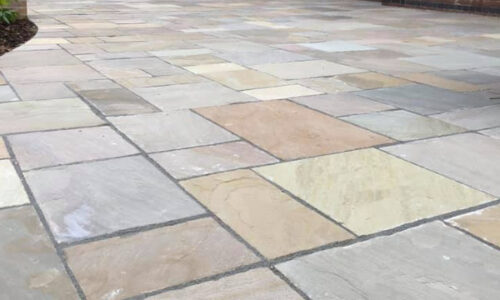Also known as kiln-dried sand, block paving sand is fine, dry sand that contains zero moisture. It is used to fill the joints in block paving to prevent movement and keep the pavers in place, while also preventing water ingress.
Why is Block Paving Sand Kiln Dried?
Block paving sand is dried in a kiln to ensure all moisture is removed before use. This dry sand flows more easily into the joints in a block paved driveway or patio, instead of sticking to the side or surface of the pavers.
In turn, this ensures the joints are fully filled with sand, which strengthens the structure of the block paving when the surface is compacted with a wacker plate. The result is block paving that is held firmly in place, providing you with a long-lasting patio or place to park.
As well as preventing movement of the paving blocks, this tightly compacted sand also stops water from seeping into a block paved driveway or patio, so you won’t have to worry about water damage after heavy rainfall.
When To Use Block Paving Sand
After block pavers have been laid in the desired pattern, block paving sand should be spread over the surface and swept into the joints using a brush. Completing this step locks the individual pavers together, so you are left with a strong and sturdy driveway or patio.
Block paving sand can also be used throughout the life of your block paving to replace any sand that has been displaced and keep the pavers securely in place.
Why Re-Sand Block Paving
When cleaning block paving to remove dirt or debris, some of the kiln-dried sand can become displaced, especially when using a pressure washer. It is important to replace any lost sand to prevent movement in the block paving and prolong its lifespan. Fortunately, this is a relatively simple DIY job that only requires block paving sand and a soft-bristled broom.
How To Re-Sand Block Paving
If re-sanding block paving yourself, follow these simple steps to restore your patio or driveway to its best.
- Make sure you use specific block paving sand that has been kiln-dried, not cheaper builders’ sand. Builders’ sand contains moisture so won’t effectively fill the joints between the pavers.
- Let the driveway or patio dry completely before re-sanding, as any moisture could cause the sand to stick to the surface of the block paving, rather than flowing into the joints.
- Brush sand over the entire surface using a soft-bristled broom, ensuring all joints are fully filled with sand.
- Sweep away any excess without removing the sand that has settled in the paving joints.
Enquire About New Block Paving
If you are looking to refresh your garden with new block paving, Ultimate Landscapes can help. Whether replacing an existing driveway or creating a new patio area, we can bring your landscaping plans to life.
Call us on 0116 4318 489 to speak to our team, or complete our contact form to start an enquiry.
Posted in Latest News, Block Paving


